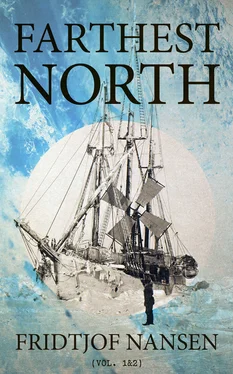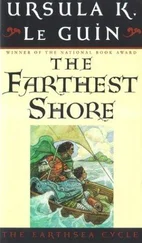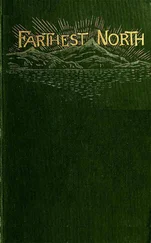“1. A list of provisions, signed by De Long, the commander of the Jeannette .
“2. A MS. list of the Jeannette’s boats.
“3. A pair of oilskin breeches marked ‘Louis Noros,’ the name of one of the Jeannette’s crew, who was saved.
“4. The peak of a cap on which, according to Lytzen’s statement, was written F. C. Lindemann . The name of one of the crew of the Jeannette , who was also saved, was F. C. Nindemann. This may either have been a clerical error on Lytzen’s part or a misprint in the Danish journal.
“In America, when it was reported that these articles had been found, people were very sceptical, and doubts of their genuineness were expressed in the American newspapers. The facts, however, can scarcely be sheer inventions; and it may therefore be safely assumed that an ice-floe bearing these articles from the Jeannette had drifted from the place where it sank to Julianehaab.
“By what route did this ice-floe reach the west coast of Greenland?
“Professor Mohn, in a lecture before the Scientific Society of Christiania, in November, 1894, showed that it could have come by no other way than across the Pole. 3
“It cannot possibly have come through Smith Sound, as the current there passes along the western side of Baffin’s Bay, and it would thus have been conveyed to Baffin’s Land or Labrador, and not to the west coast of Greenland. The current flows along this coast in a northerly direction, and is a continuation of the Greenland polar current, which comes along the east coast of Greenland, takes a bend round Cape Farewell, and passes upward along the west coast.
“It is by this current only that the floe could have come.
“But the question now arises: What route did it take from the New Siberian Islands in order to reach the east coast of Greenland?
“It is conceivable that it might have drifted along the north coast of Siberia, south of Franz Josef Land, up through the sound between Franz Josef Land and Spitzbergen, or even to the south of Spitzbergen, and might after that have got into the polar current which flows along Greenland. If, however, we study the directions of the currents in these regions so far as they are at present ascertained, it will be found that this is extremely improbable, not to say impossible.”
Having shown that this is evident from the Tegethoff drift and from many other circumstances, I proceeded:
“The distance from the New Siberian Islands to the 80th degree of latitude on the east coast of Greenland is 1360 miles, and the distance from the last-named place to Julianehaab 1540 miles, making together a distance of 2900 miles. This distance was traversed by the floe in 1100 days, which gives a speed of 2.6 miles per day of 24 hours. The time during which the relics drifted after having reached the 80th degree of latitude, till they arrived at Julianehaab, can be calculated with tolerable precision, as the speed of the above-named current along the east coast of Greenland is well known. It may be assumed that it took at least 400 days to accomplish this distance; there remain, then, about 700 days as the longest time the drifting articles can have taken from the New Siberian Islands to the 80th degree of latitude. Supposing that they took the shortest route— i. e. , across the Pole—this computation gives a speed of about 2 miles in 24 hours. On the other hand, supposing they went by the route south of Franz Josef Land, and south of Spitzbergen, they must have drifted at much higher speed. Two miles in the 24 hours, however, coincides most remarkably with the rate at which the Jeannette drifted during the last months of her voyage, from January 1 to June 12, 1881. In this time she drifted at an average rate of a little over 2 miles in the 24 hours. If, however, the average speed of the whole of the Jeannette’s drifting be taken, it will be found to be only 1 mile in the 24 hours.
“But are there no other evidences of a current flowing across the North Pole from Bering Sea on the one side to the Atlantic Ocean on the other?
“Yes, there are.
“Dr. Rink received from a Greenlander at Godthaab a remarkable piece of wood which had been found among the drift-timber on the coast. It is one of the ‘throwing sticks’ which the Eskimo use in hurling their bird-darts, but altogether unlike those used by the Eskimo on the west coast of Greenland. Dr. Rink conjectured that it possibly proceeded from the Eskimo on the east coast of Greenland.
“From later inquiries, 4however, it appeared that it must have come from the coast of Alaska in the neighborhood of Bering Strait, as that is the only place where ‘throwing sticks’ of a similar form are used. It was even ornamented with Chinese glass beads, exactly similar to those which the Alaskan Eskimo obtain by barter from Asiatic tribes, and use for the decoration of their ‘throwing sticks.’
“We may, therefore, with confidence assert that this piece of wood was carried from the west coast of Alaska over to Greenland by a current the whole course of which we do not know, but which may be assumed to flow very near the North Pole, or at some place between it and Franz Josef Land.
“There are, moreover, still further proofs that such a current exists. As is well known, no trees grow in Greenland that can be used for making boats, sledges, or other appliances. The driftwood that is carried down by the polar current along the east coast of Greenland and up the west coast is, therefore, essential to the existence of the Greenland Eskimo. But whence does this timber come?
“Here our inquiries again carry us to lands on the other side of the Pole. I have myself had an opportunity of examining large quantities of driftwood both on the west coast and on the east coast of Greenland. I have, moreover, found pieces drifting in the sea off the east coast, and, like earlier travellers, have arrived at the conclusion that much the greater part of it can only have come from Siberia, while a smaller portion may possibly have come from America. For amongst it are to be found fir, Siberian larch, and other kinds of wood peculiar to the north, which could scarcely have come from any other quarter. Interesting in this respect are the discoveries that have been made on the east coast of Greenland by the second German Polar Expedition. Out of twenty-five pieces of driftwood, seventeen were Siberian larch, five Norwegian fir (probably Picea obovata ), two a kind of alder ( Alnus incana ?), and one a poplar ( Populus tremula ? the common aspen), all of which are trees found in Siberia.
“By way of supplement to these observations on the Greenland side, it may be mentioned that the Jeannette expedition frequently found Siberian driftwood (fir and birch) between the floes in the strong northerly current to the northward of the New Siberian Islands.
“Fortunately for the Eskimo, such large quantities of this driftwood come every year to the coasts of Greenland that in my opinion one cannot but assume that they are conveyed thither by a constantly flowing current, especially as the wood never appears to have been very long in the sea—at all events, not without having been frozen in the ice.
“That this driftwood passes south of Franz Josef Land and Spitzbergen is quite as unreasonable a theory as that the ice-floe with the relics from the Jeannette drifted by this route. In further disproof of this assumption it may be stated that Siberian driftwood is found north of Spitzbergen in the strong southerly current, against which Parry fought in vain.
“It appears, therefore, that on these grounds also we cannot but admit the existence of a current flowing across, or in close proximity to, the Pole.
Читать дальше












